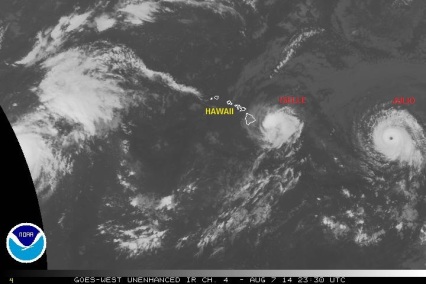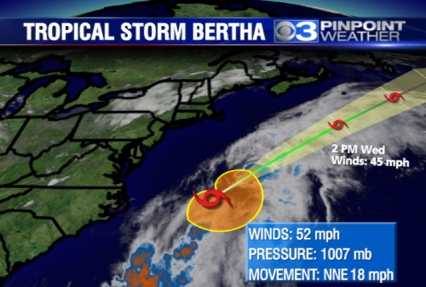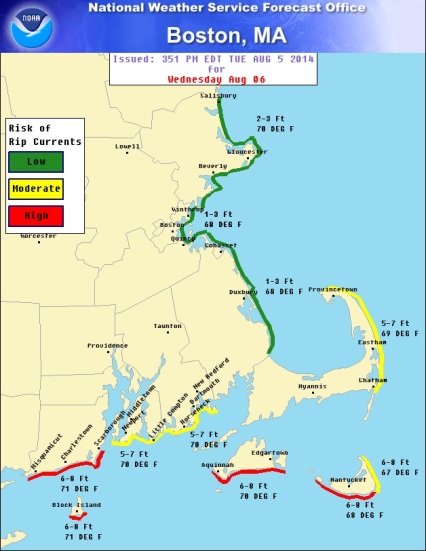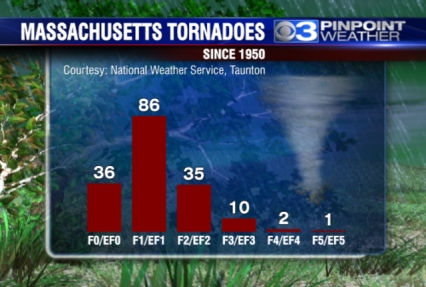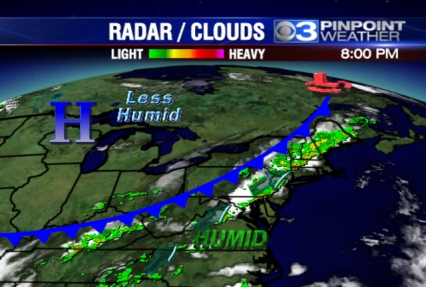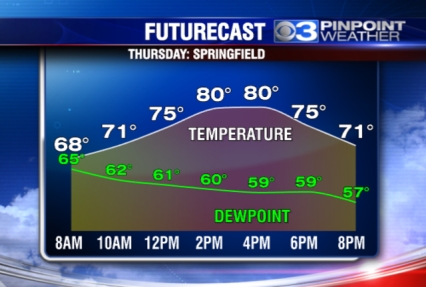By Meteorologist Mike Skurko
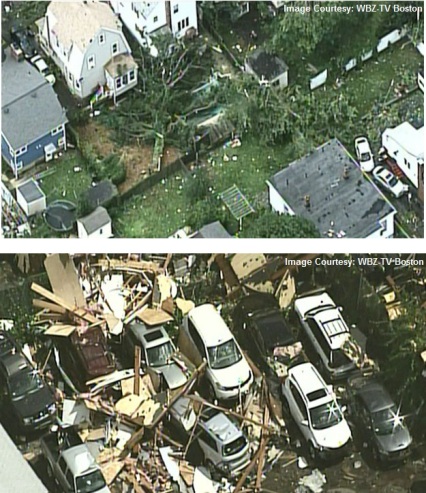
An EF-2 tornado touched down just north of Boston in the town of Revere, MA on Monday morning. Estimated wind speeds reached 120 mph. Fortunately, no injuries were reported despite the unusual time the tornado touched down (9:32 a.m.). According to the National Weather Service, this is the first tornado in Suffolk County since records began in 1950.
Below is the National Weather Service’s official statement regarding this storm:
Public Information Statement
National Weather Service Taunton, MA
432 PM EDT Mon Jul 28 2014
…Tornado confirmed in Suffolk County MA…
Location…Chelsea and Revere in Suffolk County MA
Date… July 28 2014
Estimated time…9:32 – 9:36 AM EDT
Maximum EF-scale rating…EF2
Estimated maximum wind speed…120 mph
Maximum path width…3/8 of a mile
Path length…2.0 miles
Beginning lat/lon…42.3980 / -71.0219
Ending lat/lon…42.4225 / -71.0037
* fatalities…0
* injuries…0
* The information in this statement is preliminary and subject to change pending final review of the event(s) and publication in NWS storm data.
…Summary…
The National Weather Service in Taunton, MA has confirmed that a tornado touched down on the morning of july 28, 2014 in Chelsea and Revere in Suffolk County, Massachusetts. It had a path length of 2 miles and path width of 3/8 of a mile. Most damage had a rating of EF-1 on the Enhanced Fujita scale but EF-2 damage was observed in the vicinity of Revere Beach Parkway. Thus this event is classified as an EF-2 tornado. Maximum wind gusts were estimated at between 100 and 120 mph. Thankfully and miraculously there were no fatalities or injuries reported as a result of this tornado.
Although the tornado began in Chelsea…where a window was reported to have been blown out on Dudley Street…the overwhelming majority of damage occurred in the town of Revere.
The tornado moved across the Chelsea River…directly across the Paul Cronin Memorial Skating Rink…and portions of its roof were blown northeastward across Route 16. Numerous houses on Revere Beach Parkway were severely impacted…with one roof completely blown off. In that vicinity…large oak trees were snapped mid-way up. Just to the east of the on-ramp from Route 107 to Route 16…trees were downed from west to east. Trees just to the west of Wilson Street were downed from east to west. This gave a clear delineation of the track of the tornado…which is low pressure and has trees blowing in toward the track. Some trees and tree limbs were lifted up and deposited on top of houses immediately behind Revere Beach Parkway.
The damage was widespread throughout much of the center of Revere. The tornado traveled northward…basically following Route 107/Broadway. At the town hall…windows were blown out and there was roof damage. A large birch tree was uprooted there. More than a hundred homes had damage that ranged from siding torn off to portions of roofs lifted or blown off. There were several store signs that were destroyed. Debris from homes could be seen collecting on fences. Trees fell on several cars with a few being crushed.
The police reported that a car had been overturned…to the west of Broadway at the intersection of Malden Street and Carlson
Avenue. The damage path continued northward to just beyond the rotary at Route 60. Near that rotary there was a billboard lying on top of several cars.
The total path length was 2 miles and the path width was approximately 3/8 of a mile…with a sharp cutoff of the damage just east of American Legion Highway/Route 60.
The National Weather Service would like to extend its appreciation to our North Shore and Boston SKYWARN Amateur Radio Coordinators…the Massachusetts Emergency Management Agency Region 1 office…and the Revere Police Department for helping us tremendously with this storm survey.

